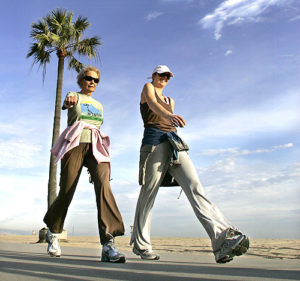 On average, a person walks about 115,000 miles in his or her lifetime, roughly equal to four trips around the Earth! (According to the American Podiatric Medical Association). So, since we are walking (a lot) anyway it makes good sense to refine our gait to optimize its affect on our health and wellness. If walking influences our physiology and anatomy in a positive direction, that repetition adds up. It’s cumulative. And likewise, it can go in the other direction.
On average, a person walks about 115,000 miles in his or her lifetime, roughly equal to four trips around the Earth! (According to the American Podiatric Medical Association). So, since we are walking (a lot) anyway it makes good sense to refine our gait to optimize its affect on our health and wellness. If walking influences our physiology and anatomy in a positive direction, that repetition adds up. It’s cumulative. And likewise, it can go in the other direction.
In the last article we identified the tendency for individuals to elevate the hip/pelvic girdle while walking. This up and down movement is being initiated by the side or lateral muscles. Now we will look at gait movement from the front-to-back.
In analyzing this component of gait we first look for swaying, arching or compression in the lower back. You know that if someone arches their back a lot when they walk and there’s already compression, then there’s going to be increased pressure. This lordotic type of gait will also exacerbate any existing disk impingement in the lower back.
To better understand this concept of lower back positioning check out these two pictures. Note that in both images the fingers are pointing in the same direction as the pelvic girdle.
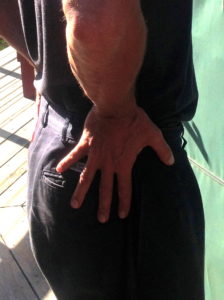
In the first picture the bottom of the hip girdle elevates and moves back while the top moves forward and up. This arched stance creates compression at the lower back and disks.
In the second picture the bottom of the pelvic girdle moves down and forward while the top moves back and down. This is the stance we want in our walking gait as it creates extension in the lower back and disks.
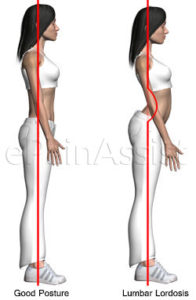 Unfortunately when we start walking with the pattern in the first photo at a young age, we strengthen the muscle-ligament structure in that area and it becomes part of how we generate our walk. We actually redefine which muscles we use to walk so that the very muscles which are critical for extension of the lower lumbar, now work toward compression instead. That’s why lower back issues can become so chronic and difficult to resolve. For those with this type of gait, true resolution of lower back issues is nearly impossible without a gait adjustment that focuses on rotating the pelvic bone to extend the lower back vertebrae. This is a seemingly small adjustment with a tremendous effect.
Unfortunately when we start walking with the pattern in the first photo at a young age, we strengthen the muscle-ligament structure in that area and it becomes part of how we generate our walk. We actually redefine which muscles we use to walk so that the very muscles which are critical for extension of the lower lumbar, now work toward compression instead. That’s why lower back issues can become so chronic and difficult to resolve. For those with this type of gait, true resolution of lower back issues is nearly impossible without a gait adjustment that focuses on rotating the pelvic bone to extend the lower back vertebrae. This is a seemingly small adjustment with a tremendous effect.
The other key component of the front-to-back movement is elongation of the inner-leg area. Every part of the leg – front, inside, back and outside – has unique responsibilities. And that inside part is responsible for circulation. There are gallons of fluid in that crucial location and elongation will work to enhance circulation. It can be hard to feel extension at the inner leg but you can be assured that if you don’t feel extension in the front leg you’re getting even less on the inside.
The passive lunge stretch is an excellent way to experience that front and inner leg extension. Do the stretch and notice what you feel and where, then when you walk create that same extension. This stretch should be accessible to everyone:
- Stand with your right foot in front of your left in a wide stance.
- Lower your left knee to the ground, padding it with a blanket or cushion.
- Place your hands on the ground on the inside of your right foot.
- Stay and breathe.
- Switch legs and repeat.
You may need to scoot your left knee back in order to get your hands on the ground. Your right leg from ankle to knee should be perpendicular to the floor. It is important NOT to extend the right knee forward beyond this point.
Please start slowly, going a little deeper with each breath. If you feel any pain in this position discontinue immediately.
Refining your gait will enhance your overall well-being in various ways. Increased circulation and relief from lower back discomfort are two of the benefits of such biomechanic adjustment. So give your gait the attention it deserves. Keep on walking around the earth for as long as possible. Extend the lower back and elongate the inner legs and you will feel better forever.

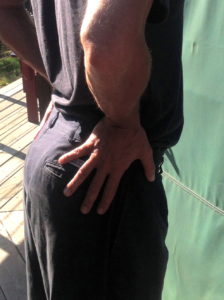
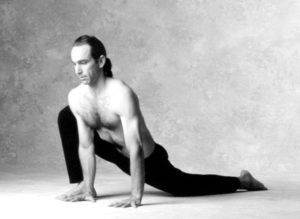
Hello,
I am a therapist and would love to have all six exercises for the gaits.
Could you please let me know what do I do?
Thank you
Jacob